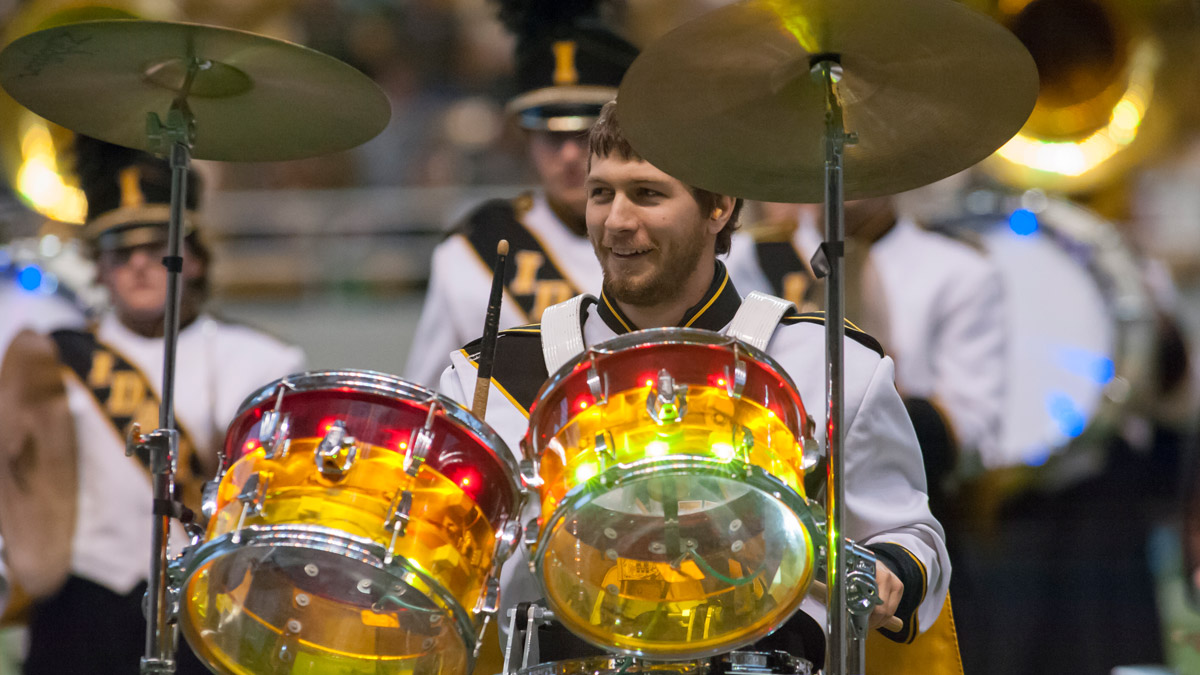Rolling with the Beat

Human Assisted Robotic Drumset with LED Lightshow
A collaboration with UI Departments of Mechanical Engineering (Human Assisted Robotic Drumset) and Computer Science (LED Light Show).
The University of Idaho’s newest marching band member has three legs, 30 flashing LED lights and an electronic brain.
The Human-Assisted Robotic Drumset, nicknamed the Band-Beesten, is the newest star of the Sound of Idaho. It’s a joint project between students and faculty in mechanical engineering, computer science and music – and there’s nothing quite like it anywhere else in the world. The drum set walks with its drummer.
“This is a one-of-a-kind, brainchild type of thing,” says mechanical engineering graduate student Dan Mathewson, who leads the team that developed the Band-Beesten, which is named in reference to a Dutch inventor’s walking robot.
When Sound of Idaho director Spencer Martin was introduced to the Band-Beesten over the summer, he couldn’t pass up the chance to add this rare robot to his band.
“Done right, this really could revolutionize what marching bands are doing at all levels,” he says. “That’s the goal — getting on the forefront of this and doing something unique and different.”
The idea for a robotic drum set began with a chance meeting between faculty members Dan Bukvich of the Lionel Hampton School of Music and Edwin Odom of the department of mechanical engineering. As Odom recalls, Bukvich mentioned he would like to have a big set of moving drums on the field.
A group of engineering students took on the idea. But their first few prototypes had wobbly wheels, made awkward turns and couldn’t support the unwieldy drums. They had to make the set as agile as the band member playing it.
Odom, Mathewson and a team of senior engineering students – Chris Ohlinger, Steven Watts and Travis Doerzaph – found the solution: a recently developed kind of robot known as a ballbot.
“That’s one of the greatest things about being at the university. Being able to collaborate with all these different departments, being able to do things that aren’t being done anywhere else.”
Rather than moving on legs or wheels, a ballbot balances on top of a sphere. So they balanced the Band-Beesten atop a common basketball fitted with three motors, enabling the robot to move in any direction.
Mathewson and his team built the ‘bot’ from the ground up. They even fabricated its circuitry and circuit boards in university shops, which Mathewson called an invaluable experience.
“When we walk out of the university, we’ll know more about hands-on building, machining and tooling than people at just about any other university,” he says.
But even a robot needs a buddy. Band-Beesten relies on the motions of its human drummer for direction. Sound of Idaho drumline captain Mat Schaefer wears a typical marching band harness that attaches to the set. A small computer reads his movements and tells the ballbot which direction to go.
It’s like a power-steering system, Mathewson says.
“You control it, but the motors take over the load,” he says. “That’s the fundamental concept behind this.”
The Band-Beesten allows Schaefer to play a five-piece drum set while marching, turning and even doing 360-degree spins in a way that could never be accomplished with typical marching drums. Schaefer says playing the Band-Beesten is more complicated than playing a stationary drum set, but he appreciates the range the set offers.
“I love the fact that it spins and is mobile,” he says. “There is a history of flying and moving drum sets that traces all the way back to Buddy Rich, and for good reason: audiences love it.”

To top off the Band-Beesten, computer science students added high-powered LED lights that flash through the drums’ transparent sides. They also built hardware for the lights and programmed the software that synchronizes them.
“I think it’s crucial for our students to get out of their world of computer science to see where some of the information they’re learning has application in the real world,” department of computer science faculty member Bob Rinker says.
The engineers and the Sound of Idaho unveiled the Band-Beesten during a recent halftime show at a Vandal home football game. The bot will make an appearance again at the Nov. 17 home game in the ASUI Kibbie Dome. Band-Beesten project members believe this is just the beginning.
“In the future this thing is going to expand and get much, much larger,” Mathewson says.
Martin envisions using the same type of system to create marching xylophones, marimbas and huge drum sets – which will revolutionize his band’s capabilities.
“That’s one of the greatest things about being at the university,” he says. “Being able to collaborate with all these different departments, being able to do things that aren’t being done anywhere else.”







